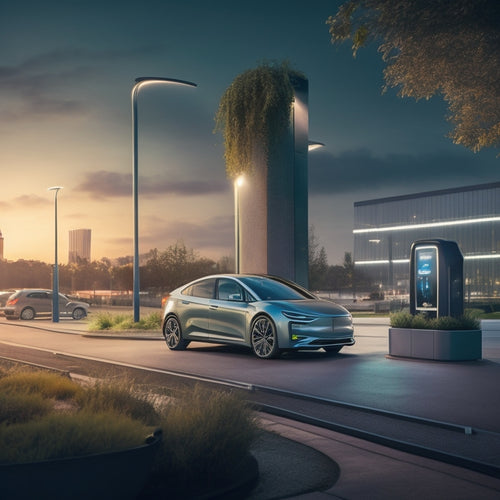
Solar Panels and Battery Cost
Share
When you invest in a solar panel and battery system, you can expect to pay between $15,000 and $30,000, depending on the system's size, quality, and features, which will be offset by significant energy savings and potentially increased property value. By locking in energy costs, you'll eliminate monthly electricity bills and enjoy predictable expenses. With average energy savings of 50% to 70%, you'll see annual savings of $400 to $1,000. As you investigate the benefits of solar and battery systems, you'll uncover even more ways to optimize your energy usage and maximize your investment.
The Essentials
- The cost of solar panels and batteries varies depending on system size, quality, and installation factors, with average costs ranging from $15,000 to $30,000.
- A well-designed solar system can save homeowners 50-70% on energy bills, translating to annual savings of $400-$1,000 and up to $20,000 over 20 years.
- High-efficiency inverter technology is critical for optimal solar performance, with efficiency ratings ranging from 95% to over 99% impacting overall system performance and savings.
- Battery cost is influenced by factors such as capacity, type, and brand, with prices ranging from $5,000 to $15,000 or more for a typical residential system.
- Federal and state incentives, as well as financing options, can significantly reduce the upfront cost of solar panels and batteries, making them more accessible to homeowners.
Zero Energy Bills Guaranteed
You can lock in energy savings guaranteed and eliminate your monthly electricity bills with a solar panel system and battery storage solution.
By utilizing renewable energy from the sun Renewable Energy, you'll not only reduce your carbon footprint but also greatly decrease your reliance on the grid, resulting in substantial savings.
With a zero energy bill guarantee, you'll enjoy predictable energy costs and a considerable reduction in your overall energy expenditure.
Energy Savings Guaranteed
The homeowner's greatest return on investment lies in the energy savings guaranteed by a well-designed solar panel system, which can effectively eliminate energy bills. With energy incentives and solar financing options available, you can enjoy significant savings on your energy costs.
Here's a breakdown of the energy savings you can expect:
| Energy Savings | Description |
|---|---|
| 50% - 70% reduction | Average energy savings for homeowners with solar panel systems |
| $400 - $1,000 per year | Typical annual energy savings for residential solar installations |
| $10,000 - $20,000 | Total energy savings over 10-20 years with solar panels |
| Increased property value | Solar panels can increase your property value by up to 4.1% |
No Monthly Bills
With a well-designed solar panel system, homeowners can bid farewell to monthly energy bills, enjoying a life free from the burden of utility payments.
You'll no longer be tied to the grid, relying on your utility company for power. By switching to renewable energy sources, such as Photovoltaic Cells, you'll not only reduce your energy costs but also contribute to a cleaner and more sustainable future. Instead, you'll generate your own clean energy, reducing your reliance on non-renewable sources and slashing your energy costs.
As you capture the power of the sun, you'll experience significant solar savings, which can add up to thousands of dollars over the system's lifetime.
This means you'll have more money in your pocket to invest in the things that matter most to you. Plus, with energy independence, you'll have the freedom to live life on your own terms, without worrying about the impact of rate hikes on your budget.
Increased Property Value
You'll likely see a significant increase to your home's equity when you install solar panels and a battery system, as they increase your property's value.
By switching to a home solar system, you can also save thousands on your electricity bill electricity bill reduction and gain energy independence.
This increase in equity can be a significant advantage, especially if you plan to sell your home in the future.
Additionally, having a solar-powered home can also enhance its resale value, making it more attractive to potential buyers.
Boosted Home Equity
Installing solar panels and batteries can greatly enhance your home's equity by increasing its property value. This increase in equity can be a significant benefit, especially for those considering a home renovation or property investment. According to a study by the National Renewable Energy Laboratory, homes with solar panels sell for an average of $15,000 more than similar homes without solar panels.
| Home Feature | Average Increase in Property Value |
|---|---|
| Solar Panels | 3-4% |
| Energy Storage System | 1-2% |
| Energy Efficiency Upgrades | 2-3% |
| Smart Home Automation | 1-2% |
Enhanced Resale Value
The incorporation of solar panels and batteries into your home greatly enhances its resale value, making it more attractive to potential buyers. This increased appeal stems from the numerous benefits associated with solar energy, including reduced energy costs, decreased carbon emissions, and increased energy independence.
As a result, your property becomes more competitive in the resale market, giving you a significant advantage over similar properties without solar installations.
Studies have consistently shown that homes with solar panels and batteries sell faster and for higher prices than those without. In fact, a National Renewable Energy Laboratory study found that solar panels can increase your home's value by up to $15,000.
This increased value is driven by buyer preferences for energy-efficient and environmentally friendly features. By installing solar panels and batteries, you can tap into this demand and reap the financial benefits when you decide to sell your home.
Ultimately, the enhanced resale value of your property provides you with a sense of freedom and security, knowing that your investment will yield a strong return in the future.
High-Efficiency Inverter Technology Explained
You're likely familiar with the significance of inverters in solar panel systems, but what makes a high-efficiency inverter stand out?
When it comes to maximizing energy savings with high-efficiency solar panels, photovoltaic systems play an essential role in utilizing renewable energy.
You'll want to understand inverter efficiency ratings, which are typically measured by the California Energy Commission (CEC) or the International Electrotechnical Commission (IEC).
As you investigate high-efficiency inverter technology, you'll also learn about maximum power tracking, a vital feature that optimizes energy production.
Inverter Efficiency Ratings
Most solar panel systems rely on inverters to convert DC power into usable AC power, making inverter efficiency a critical factor in overall system performance. You need to understand inverter efficiency ratings to guarantee you're getting the most out of your solar panel system.
Inverter efficiency is typically measured by its ability to convert DC power into AC power, with higher efficiencies meaning more usable power is generated.
When selecting an inverter, you'll come across different types, including string inverters, microinverters, and power optimizers. Each type has its own efficiency rating, ranging from 95% to over 99%. A higher efficiency rating means less energy is wasted as heat, resulting in a longer inverter lifespan.
Look for inverters with high efficiency ratings, especially if you're installing a large solar panel system.
Inverter efficiency ratings also impact your overall energy savings. A highly efficient inverter guarantees you're generating the most power possible, resulting in lower electricity bills and a faster return on your investment.
Maximum Power Tracking
Six key components work together to maximize energy harvesting in high-efficiency inverters, and one of the most critical is Maximum Power Point Tracking (MPPT).
You're likely wondering how MPPT works its magic. Essentially, it's a sophisticated control system that continuously monitors your solar panel array's output, identifying the maximum power available.
This is achieved through advanced tracking algorithms that analyze voltage and current data in real-time. By doing so, MPPT guarantees your inverter extracts the maximum power from your solar panels, even under varying environmental conditions like temperature and irradiance.
Think of it as fine-tuning your solar panel system to optimize energy production. MPPT's precision enables you to exploit the most power from your solar panels, resulting in increased energy independence and reduced reliance on the grid.
With MPPT, you can rest confident that your high-efficiency inverter is working at its best to maximize your renewable energy output.
Assess Your Energy Usage
You'll need to determine your daily energy consumption to size your solar panel system and battery correctly.
To do this, you'll want to examine your energy usage patterns, including the times of day when you use the most energy.
Residential solar energy storage systems, like those that combine photovoltaic panels with energy storage units, can help you optimize your energy usage.
Grid tie inverters play an essential role in this process.
Daily Energy Consumption
Your household's daily energy consumption is the foundation of determining the right solar panel and battery system for your needs.
To accurately assess your energy usage, you'll need to understand your daily energy consumption patterns. Conducting an energy audit will help you identify areas of high energy consumption and opportunities for improvement.
During the audit, take note of your consumption habits, including the number of people living in the household, the type and number of appliances, lighting, and electronics used.
You'll also want to reflect on your energy-intensive habits, such as laundry, cooking, and entertainment.
Record your energy usage over a period, typically a month, to get an average daily consumption. This data will help you determine the required solar panel and battery capacity to meet your energy needs.
Be precise in your calculations, as undersizing or oversizing your system can lead to inefficiencies and increased costs.
Energy Usage Patterns
Energy usage patterns vary considerably from one household to another, influenced by factors like lifestyle, appliance efficiency, and personal habits.
To accurately assess your energy usage, you need to understand your unique energy usage pattern. This involves identifying the times of day when your energy consumption is highest and lowest.
You can do this by conducting energy monitoring, which involves tracking your energy usage over a period of time. This data will provide significant revelations into your consumption analysis, allowing you to pinpoint areas where you can make adjustments to reduce your energy consumption.
For instance, you may find that your energy usage spikes in the evening when you're cooking dinner or watching TV. By identifying these patterns, you can take steps to reduce your energy consumption, such as switching to energy-efficient appliances or adjusting your daily routine.
Lower Carbon Footprint Guaranteed
You're taking an essential step towards reducing your energy dependence now by investing in solar panels and batteries.
By utilizing renewable energy, you'll markedly decrease your reliance on fossil fuels and lower your carbon footprint.
This eco-friendly approach won't only benefit the environment but also provide you with a sustainable solution for your energy needs.
Reduce Energy Dependence Now
Reduce Energy Dependence Now
Freedom from reliance on the grid beckons, and utilizing solar power is a significant step towards achieving it.
You're not just reducing your carbon footprint; you're taking a vital step towards energy independence. By capturing the sun's energy, you're no longer bound to the grid's whims, and that's liberating.
Investing in solar panels and batteries means you're choosing sustainable living.
You're reducing your reliance on fossil fuels, which is a significant contributor to climate change.
With solar power, you're generating clean energy, reducing air pollution, and decreasing greenhouse gas emissions.
Frequently Asked Questions
Can I Install Solar Panels on My Own?
You can install solar panels on your own, but it's essential to guarantee you have the necessary knowledge; consider DIY installation with solar panel kits, which provide pre-assembled components and instructions to guide you through the process.
Are Solar Panels Resistant to Extreme Weather?
You're wise to wonder if solar panels can withstand extreme weather; rest assured, they're designed with storm durability and temperature tolerance in mind, so you can utilize renewable energy with confidence, even in harsh conditions.
How Long Does the Installation Process Take?
You'll find that the installation timeline varies, but on average, it takes 3-5 days for a residential setup, depending on the complexity of the installation challenges, such as roof size and electrical connections.
Do Solar Panels Require Regular Maintenance?
As you bask in the freedom of renewable energy, you'll find that regular maintenance is a small price to pay for the long lifespan of your solar panels, which only require occasional checks every 6-12 months to guarantee peak performance.
Can I Use My Solar Panels During a Power Outage?
You can utilize solar energy storage to achieve grid independence during outages, but you'll need a specialized inverter and battery setup to do so, allowing you to tap into your stored solar power when the grid goes down.
Final Thoughts
You'll be swimming in savings, with zero energy bills guaranteed! Think of all the cash you'll stash away, month after month, year after year. Your property value will skyrocket, making your home the envy of the neighborhood. And, with our high-efficiency inverter technology, you'll be reducing your carbon footprint like a pro. So, what are you waiting for? Assess your energy usage and get ready to reap the rewards of solar panels and battery cost!
Related Posts
-

Solid State Batteries in Electric Vehicles
Solid-state batteries revolutionize electric vehicles by offering a longer lifespan and higher energy density than tr...
-

Solar Phone Chargers for Camping Essentials
Solar phone chargers are must-haves for your camping essentials, allowing you to stay connected while enjoying nature...
-

Smart Grid Technology Implementation Challenges
You'll encounter several challenges when implementing smart grid technology, particularly in cost management, scalabi...


